How to bleach gray and yellowed white things at home with soda and peroxide?
Content:
- The traditional way is boiling
- How to bleach linen without boiling at home?
- The best way to whiten
- How to bleach things with soda and hydrogen peroxide?
- Using aspirin to lighten tissues
- The cheapest way is salt
- Delicate whitening - potassium permanganate
- Use of mustard powder
- Citric Acid and Lemon Juice
- Chlorine bleaches
- Oxygen bleaches
- Optical brighteners
- Prevention of gray plaque and yellow spots
- Conclusion
The radiance of whiteness causes people to associate with cleanliness, freshness and celebration, but sooner or later light clothes lose their former appearance. Experienced housewives know how to whiten white things by removing yellow spots and gray deposits. For each type of tissue and degree of contamination, there are means and methods.
The traditional way is boiling
It was used by our grandmothers when there were no automatic washing machines. Only cotton and linen fabrics are allowed to boil. It is advisable not to apply this method for clothing.
We recommend bleaching with boiling water the following things:
- linens;
- kitchen and bath towels;
- tablecloths;
- underpants, bras;
- socks;
- baby romper and diapers.
For whitening, only utensils with an enamel coating or stainless steel are suitable. After boiling in galvanized, aluminum buckets, red-red spots may remain on white.
For 1 kilogram of things 10 liters of water are taken. The procedure is as follows:
- In a bowl of warm water, dissolve half a piece of laundry soap and 2 tablespoons of baking soda. Soak the white things for 3 hours.
- Remove the laundry and rinse thoroughly in clean water.
- Pour cold water into a large container, and put things that need to be bleached at the bottom. You can add a little ammonia or hydrogen peroxide, soap shavings.
- Turn on the hotplate.
- Bring the solution to a boil, and then make a small fire. Boil things for 1-1.5 hours.
- Cool and rinse thoroughly.
A common mistake of housewives is to immerse white things not in cold, but in boiling water. This leads to the fact that yellow spots are "sealed" on clothes and bedding.
How to bleach linen without boiling at home?
It is worth resorting to boiling linen only when there are strong and old pollution. For frequent bleaching, this method is not suitable, since it leads to thinning and destruction of tissues.
Fortunately, the store sells industrial bleaches in the form of liquids and powders. Some are suitable for hand washing clothes in warm or cold water, others are suitable for automatic machines.
There are many home remedies that allow you to return the whiteness to white things without boiling: soda, salt, ammonia, aspirin and others.
The best way to whiten
A universal tool that would be suitable for whitening all types of fabrics, things and removing all types of pollution does not exist. The best way is the one that is selected for a particular case.
To make it convenient for you to navigate in bleaching products, we suggest that you read the table:
| Way | What fabrics is suitable | What does it cope with |
|---|---|---|
| Hydrogen peroxide | Cotton, Wool | Returns whiteness to gray and yellowed things, removes traces of sweat, grease, cosmetics |
| Aspirin | Linen, wool, synthetics, cotton | Fresh spots of blood and sweat, gray coating |
| Aspirin | Cotton, Synthetics | Fresh spots of blood and sweat, gray coating |
| Salt | Cotton, Synthetics | Cotton, Synthetics |
| Potassium permanganate | Any | Deletes traces of sweat, deodorant, returns brightness to prints on white things |
| Mustard powder | Any other than silk | Gray plaque, traces of grease, yellow spots |
| Citric Acid, Lemon Juice | Cotton | Light stains on clothing: yellow coating on armpits and back |
| Chlorine bleaches: “White”, “Snow White” | Cotton, linen | Gray, yellow marks, blood |
| Oxygen-containing bleaches: “Soap nuts ECO 2”, “Persol Extra”, Oxygen | Any | Old yellow spots, fading of the fabric, traces of fat, blood, red alcohol |
| Optical brighteners: Vanisn Gold, Heitmann | Cotton (do not wash clothes and children's clothes, as particles of bleach remain in the tissues), synthetics | Masks grayness and yellowness |
And now consider each bleaching method in more detail.
How to bleach things with soda and hydrogen peroxide?
At home, it is better to start bleaching with folk remedies that every housewife has in the kitchen. They are safe for health and do not require large investments.
How to use baking soda?
- Fill a 10-liter bucket halfway with warm water and add 6 tablespoons of soda. Pour in a spoonful of ammonia and mix.
- Lower clothes (bedding) to the bottom of the bucket. Leave to soak for 2-5 hours depending on the degree of contamination.
- Rinse the white clothes thoroughly and send them to the machine for washing at a temperature of 60 degrees.
If the contamination is significant, use a 3% hydrogen peroxide solution, which is sold in any pharmacy:
- Pour a tablespoon of the solution into a 3-liter basin of water.
- Soak the white things for 30-60 minutes.
- Rinse and dry thoroughly. If the weather is sunny, hang your clothes outside.
Using hydrogen peroxide, individual specks on cotton can be removed. To do this, treat the yellow area with a solution, wait 5 minutes. Gently rub the cloth with a bar of soap and rinse with water.
Using aspirin to lighten tissues
A white T-shirt (shirt) from frequent washing has a gray tint, but you don’t want to spoil your favorite thing with bleaching? Choose the delicate methods that include aspirin. The active ingredient is acetylsalicylic acid. It penetrates deep into the tissue, removes the remnants of powders and concentrates.
How to use aspirin for whitening?
- Crush 5 tablets into powder. Dissolve in two liters of hot water.
- Soak a white T-shirt or shirt in the solution overnight.
- In the morning, wash the item manually with ordinary soap or send it to the automatic machine. You can add another 2-3 tablets of aspirin to the laundry detergent. By the way, this method is suitable for the prevention of tissue fading.
- Shake and send the item to dry.
The cheapest way is salt
Most often, salt is used to prevent yellowing of bed linen and kitchen towels: once a month, before washing, white things are soaked for 2 hours in a solution of warm water with the addition of 2-3 tablespoons of salt.
If you need to bleach grayed-out things, salt is used in conjunction with hydrogen peroxide, baking soda, ammonia or boric acid. Sodium chloride enhances the effect of these bleaches.
The procedure is as follows:
- Add 3 tablespoons of salt and hydrogen peroxide, a teaspoon of ammonia and a little washing powder to a bowl of hot water.
- Dip things in the basin for 2 hours, and then wash.
- Rinse and dry.
Delicate whitening - potassium permanganate
Use this method if you want to return sparkling whiteness to silk blouses and dresses. Potassium permanganate acts gently and does not destroy delicate tissue. True, it will not help to get rid of old spots.
- Prepare a solution of 10 liters of water, half baby soap and 4 crystals of potassium permanganate.
- Soak a thing for 6-8 hours.
- Rinse and dry.
Use of mustard powder
Mustard is the best home remedy for removing stains of fat from white things. Housewives use mustard powder to care for cotton tablecloths, towels, kitchen curtains.
The procedure is as follows:
- Dissolve a bag of mustard powder in 5 liters of hot water.
- Leave things in solution for 3 hours.
- Rinse with clean water so that no traces of mustard remain, and send to the washing machine.
- Dry the white things.
Citric Acid and Lemon Juice
These products perfectly remove gray and yellow deposits, but they act toughly, therefore they are suitable only for cotton fabrics. Also, with the help of citric acid, stains on shoes are removed: sneakers, ballet shoes from textiles.
- Dissolve 10 tablespoons of citric acid or two citrus juice in a 10-liter bucket of hot water.
- Soak the white things for 5-6 hours.
- Rinse and dry.
Chlorine bleaches
In the past, our mothers and grandmothers often used the Whiteness chlorine industrial product for whitening. And now it can be found on sale in the form of a liquid or powder. It’s worth a mere penny, but it perfectly removes a grayish coating and any old spots, including sweat, fat, blood, wine, grass.
But White has a number of significant drawbacks.
- not suitable for wool, delicate fabrics, synthetics, things of white color with bright patterns;
- with frequent use leads to thinning of the fabric, the formation of holes, scuffs, yellow stains;
- in some people, it causes allergic reactions to the skin;
- It smells bad;
- chlorine vapors are unsafe for respiratory organs, irritate the mucous membranes of the eyes.
Use chlorine bleach only with rubber gloves. You need to try not to inhale the smell, and after processing the white things, ventilate the apartment.
How to whiten white things using "White"?
- Soak the laundry in water with soap (half a piece) for 2 hours.
- Wash by hand.
- Pour cold water into a 3-liter basin. Add a tablespoon of bleach.
- Pour the resulting liquid into a container with white things. Leave on for 15-20 minutes.
- Rinse and dry thoroughly.
Chlorine reacts with metals, so it can harm the washing machine. Although some manufacturers leave a note “Automatic” on the packaging of funds, it’s not worth the risk. Wash white items with Whiteness manually.
Oxygen bleaches
The main advantage of such products is delicate whitening. With their help, grayness is removed even on silk blouses and dresses. Oxygen-containing bleaches disinfect tissues and remove unpleasant odors.
Substances are easily rinsed out, so later on people do not have allergic skin irritations. Suitable for whitening baby items.
But oxygen-containing bleaches also have two drawbacks: high consumption and high cost.
Optical brighteners
They are quite expensive. After washing with optical bleach, things get a crystal clear look. But this impression is misleading.
The fact is that optical brighteners contain fluorescent substances that are not completely rinsed out and remain on the fabric. After drying, the particles reflect light, and bed linen and clothing emit a white glow. Unfortunately, when in contact with the skin, fluorescent substances can cause allergies.
The use of optical brighteners is recommended when you urgently need to give things a snow-white appearance.
Prevention of gray plaque and yellow spots
Unfortunately, frequent bleaching leads to tissue becoming brittle and thin. In the end, the thing does not withstand the effects of aggressive substances and deteriorates.
And sometimes clothes are so hopelessly spoiled that it is no longer possible to bleach them. Therefore, it is important to regularly take care of your things, observe the rules of washing and drying.
We suggest you familiarize yourself with a few tips:
- Send white things to the machine immediately, do not wait until the basket is filled with dirty linen to the brim.
- Wash colored and white items separately.
- Once a month, add salt, baking soda or powder oxygen bleach to the machine before washing.
- Thoroughly rinse the laundry: residues of powders and concentrates lead to a gray coating on clothing.
- Do not wash cotton and linen at the same time as wool or synthetics.
- Do not mix clothes with other things: bedding, kitchen towels, underpants and socks.
- Observe the temperature indicated on the label.
- If possible, dry your clothes in the sun.
- Do not put wet items in the closet, otherwise they will fade.
Conclusion
Whitening is a delicate matter. If you lose sight of even one detail, you can ruin the white thing forever. Before choosing this or that method, be sure to study the composition of the fabric and the permissible temperature regime on the label. Always start whitening with delicate methods, and if they do not help, move on to harder ones.
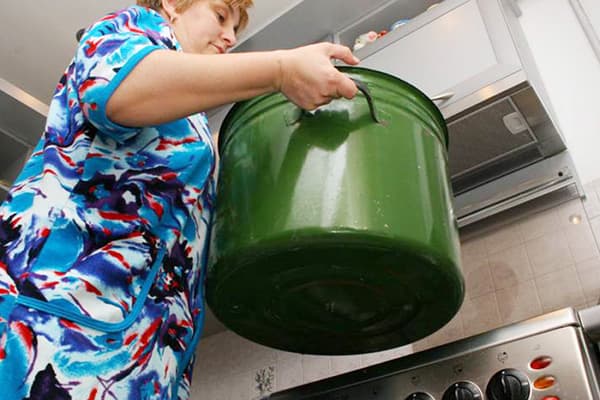
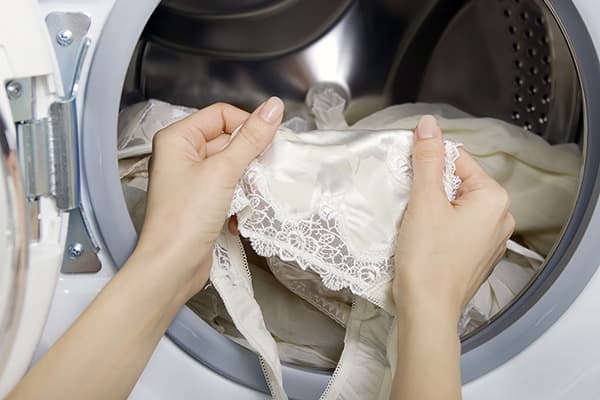
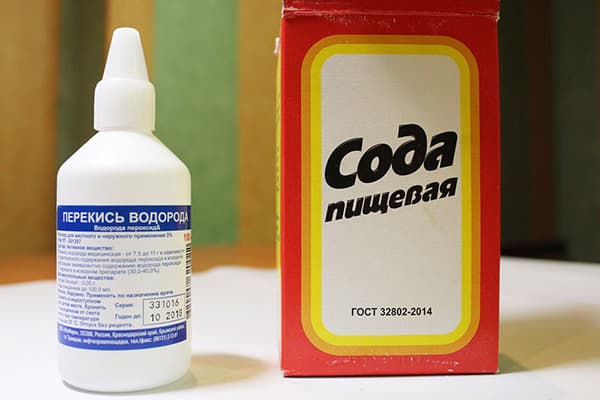
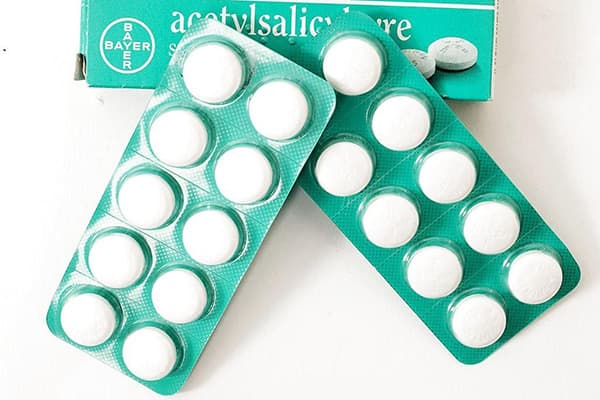
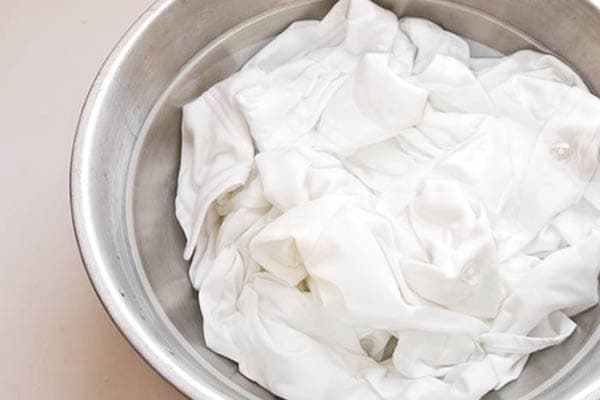
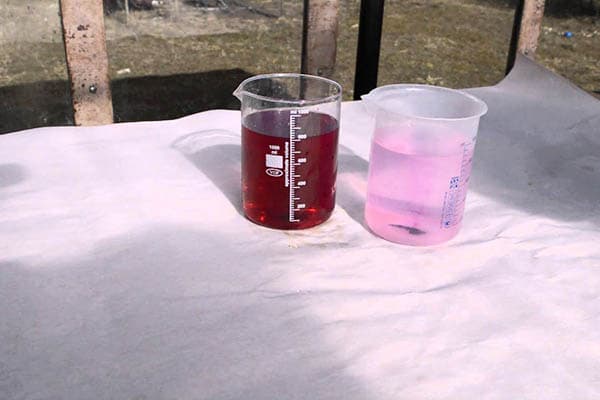
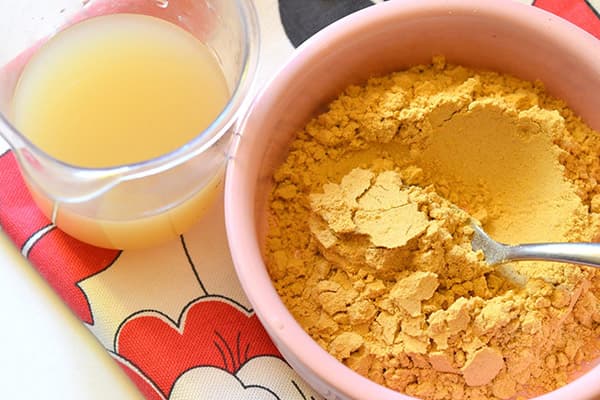
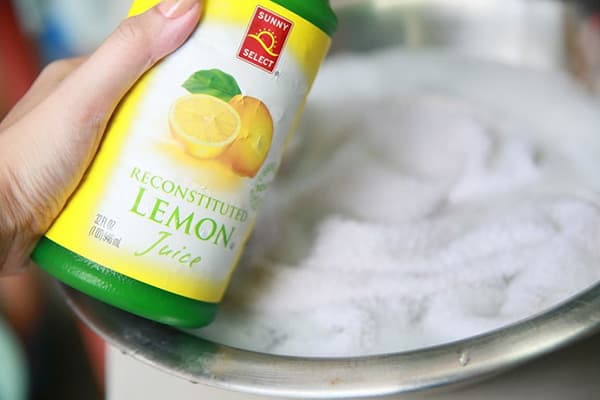
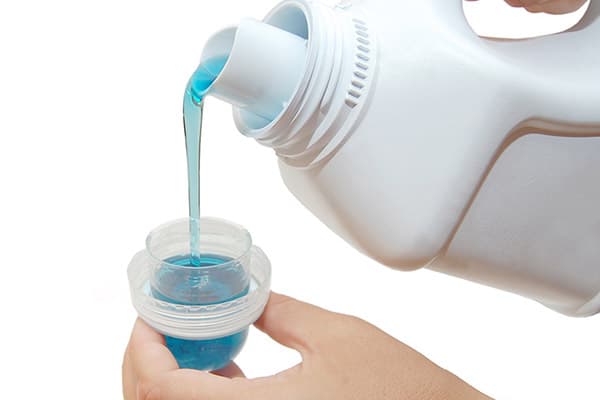
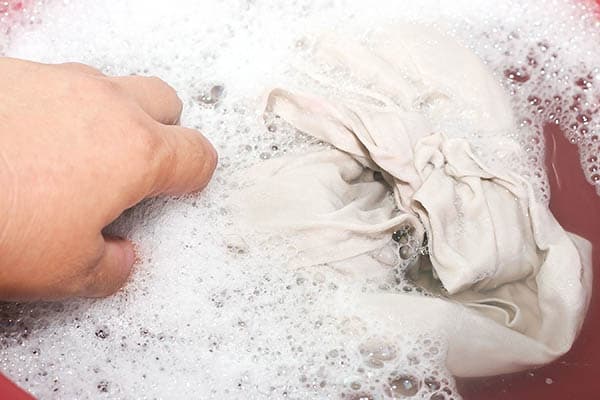
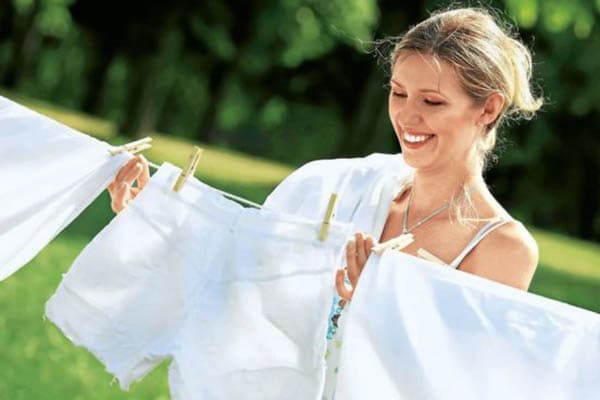
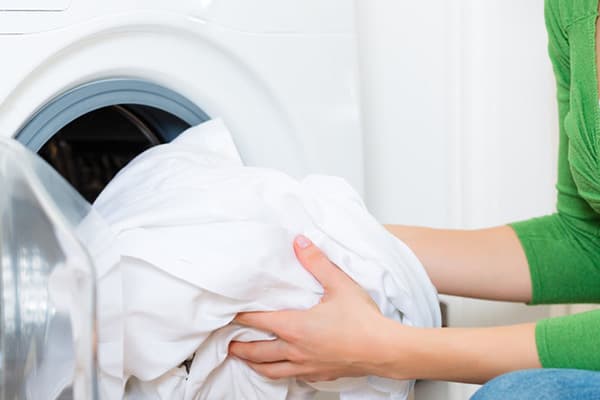
Thank you so much!!! Need to try.